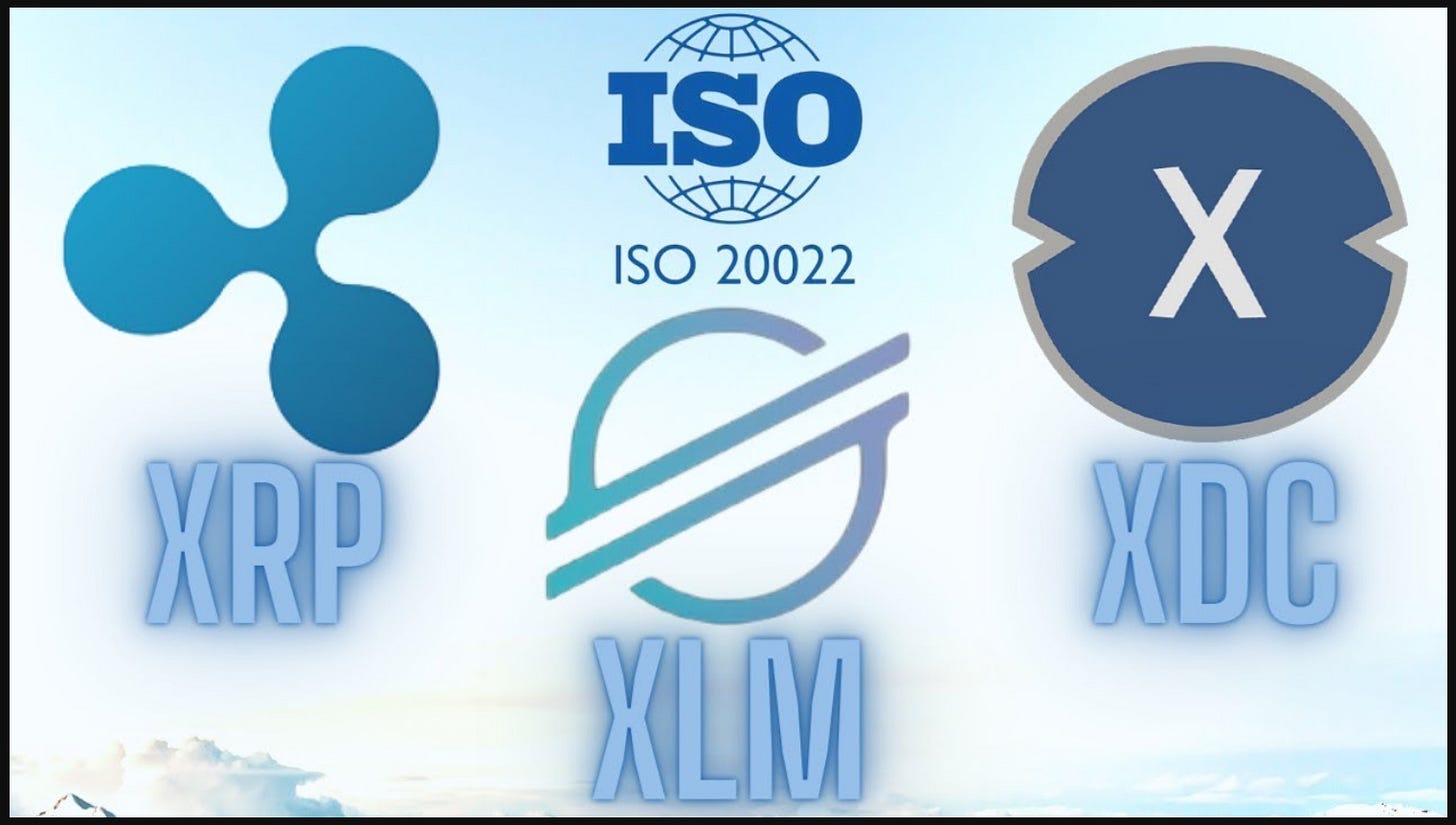I wanted to take time today to expand on a few different crypto digital assets within the same article to provide a deeper understanding of the current market conditions and the individual roles of XRP, RLUSD, XLM, XDC, the ISO 20022 standard, and their relationships with the derivatives market, the Chicago Board of Trade, and the new broader financial ecosystem.
ISO 20022: The Backbone of Financial Interoperability
The ISO 20022 standard is not just a technical upgrade; it is a paradigm shift in how financial institutions communicate. It replaces legacy messaging formats like SWIFT MT with a more data-rich, flexible, and standardized framework. This is critical because the global financial system is fragmented, with different countries and institutions using incompatible systems. ISO 20022 provides a common language, enabling seamless communication across borders and systems.
Current Market Conditions and ISO 20022
The transition to ISO 20022 is happening in phases, with SWIFT mandating its adoption for cross-border payments by 2025. This shift is creating opportunities for blockchain-based assets like XRP, XLM, and XDC, which are ISO 20022-compliant. These assets are uniquely positioned to integrate with the new standard, offering faster, cheaper, and more transparent solutions compared to traditional systems.
For example:
XRP: Ripple has been actively working to align its solutions with ISO 20022, making XRP a natural fit for cross-border payments in the new financial ecosystem.
XLM: Stellar's focus on retail payments and financial inclusion aligns with ISO 20022's goal of harmonizing global financial systems.
XDC: XinFin's enterprise-grade blockchain is designed for trade finance, a sector that will benefit significantly from ISO 20022's enhanced data capabilities.
The adoption of ISO 20022 is not just about compliance; it is about staying competitive in a rapidly evolving financial landscape. Institutions that fail to adapt risk being left behind.
XRP: The Liquidity Engine
XRP's primary use case is as a bridge asset for cross-border payments. Ripple's On-Demand Liquidity (ODL) solution leverages XRP to eliminate the need for pre-funded nostro/vostro accounts, which tie up billions of dollars in dormant capital. By using XRP, financial institutions can settle transactions in seconds, reducing costs and freeing up liquidity.
Current Market Conditions and XRP
XRP's role in the financial ecosystem has been bolstered by Ripple's legal victory against the SEC in 2023, which clarified that XRP is not a security. This has renewed interest from institutional players, particularly in regions like Asia and the Middle East, where Ripple has established strong partnerships.
Ripple's focus on integrating XRP with ISO 20022 and its partnerships with central banks for CBDC development further solidify its position as a key player in the future of finance. However, XRP faces competition from other blockchain solutions and skepticism from traditional financial institutions, which are cautious about adopting decentralized assets.
RLUSD: Ripple’s Stablecoin Solution
RLUSD, Ripple's USD-backed stablecoin, is designed to complement XRP by providing a stable medium of exchange. Unlike XRP, which is subject to market volatility, RLUSD is pegged to the US dollar and backed by reserves that include cash and short-term U.S. Treasury bonds. This makes it ideal for use cases where price stability is critical, such as payments, tokenization, and DeFi.
Current Market Conditions and RLUSD
like RLUSD are gaining traction as regulators and institutions recognize their potential to modernize payments and financial services. RLUSD's integration with the Federal Reserve's FedNow system highlights its growing acceptance within traditional finance. By providing a stable, regulated digital asset, RLUSD bridges the gap between blockchain technology and the traditional financial system.
However, the stablecoin market is becoming increasingly competitive, with players like USDC and USDT dominating the space. RLUSD's success will depend on its ability to differentiate itself through regulatory compliance, transparency, and integration with Ripple's broader ecosystem.
XLM: Financial Inclusion at Scale
Stellar Lumens (XLM) is often seen as the "people's currency," focusing on financial inclusion and low-cost payments. Stellar's blockchain is designed to facilitate fast, affordable transactions, making it ideal for remittances and microtransactions. Its partnerships with organizations like MoneyGram and Circle (USDC) demonstrate its commitment to democratizing access to financial services.
Current Market Conditions and XLM
XLM is well-positioned to benefit from the growing demand for financial inclusion, particularly in developing countries. Stellar's focus on retail use cases and its ISO 20022 compliance make it a strong contender in the global payments space. However, XLM faces challenges from other blockchain solutions and the slow pace of adoption in some regions.
Stellar's strategy of partnering with traditional financial institutions and leveraging its blockchain for CBDC development could help it gain a foothold in the evolving financial ecosystem.
XDC: The Blockchain for Trade Finance
XinFin's XDC token is designed for trade finance, a sector that has long been plagued by inefficiencies, high costs, and a lack of transparency. By tokenizing trade finance assets, XDC enables faster settlement, reduced costs, and improved liquidity. Its enterprise-grade blockchain is tailored for institutional use, making it a natural fit for trade finance and supply chain applications.
Current Market Conditions and XDC
The trade finance market is ripe for disruption, with blockchain technology offering solutions to longstanding challenges. XDC's focus on tokenization and its integration with ISO 20022 make it a strong contender in this space. Its partnerships with institutions like the Trade Finance Distribution Initiative (TFDi) highlight its growing influence in the sector.
However, XDC faces competition from other blockchain solutions and the slow pace of adoption in the trade finance industry. Its success will depend on its ability to demonstrate tangible benefits and gain the trust of institutional players.
The Derivatives Market and Blockchain
The derivatives market, valued at over $1 quadrillion, is the largest financial market in the world. It is a market that thrives on speculation, hedging, and risk management. However, it is also a market that suffers from inefficiencies, particularly in the settlement process. Blockchain technology has the potential to revolutionize this market by providing transparency, reducing counterparty risk, and enabling real-time settlement.
Current Market Conditions and Blockchain
The integration of blockchain technology into the derivatives market is still in its early stages, but the potential is enormous. By tokenizing derivatives contracts and leveraging blockchain's transparency and immutability, assets like XRP, XDC, and RLUSD can address key challenges in the market.
For example:
XRP: Its role as a bridge asset makes it ideal for providing liquidity in the derivatives market.
XDC: Its focus on tokenization and enterprise use cases aligns with the needs of the derivatives market.
RLUSD: Its stability makes it a suitable medium of exchange for tokenized derivatives.
The Chicago Board of Trade (CBOT) and other derivatives exchanges are beginning to explore blockchain solutions, but widespread adoption will require overcoming regulatory and technological hurdles.
The Federal Reserve, SWIFT, and the New Financial Order
The Federal Reserve's FedNow system represents a step toward modernizing the U.S. financial infrastructure. By enabling real-time payments, FedNow addresses a key inefficiency in the traditional financial system. Ripple's RLUSD, with its integration into FedNow, highlights the growing acceptance of blockchain-based solutions within traditional finance.
SWIFT, on the other hand, is facing an existential challenge. As blockchain-based systems like RippleNet gain traction, SWIFT must adapt or risk becoming obsolete. The ISO 20022 standard provides a pathway for SWIFT to modernize, but the rise of assets like XRP, XLM, and XDC suggests that the future of finance may lie outside its control.
Current Market Conditions
The Federal Reserve and SWIFT are at a crossroads. The adoption of blockchain technology and ISO 20022 is forcing these institutions to rethink their roles in the financial ecosystem. While SWIFT is working to modernize its infrastructure, the rise of blockchain-based solutions poses a significant threat to its dominance.
A New Financial Ecosystem
The relationships between RLUSD, XRP, XLM, XDC, the ISO 20022 standard, and the traditional financial system are complex and interdependent. Together, these assets and standards are laying the foundation for a new financial ecosystem—one that is faster, more efficient, and more inclusive.
However, the path to this new ecosystem is fraught with challenges. Regulatory uncertainty, technological barriers, and resistance from traditional institutions are all obstacles that must be overcome. But as the smoke clears and the mirrors shatter, one thing is certain: the future of finance is being built on blockchain. This expanded version provides a deeper dive into each topic, offering a more comprehensive understanding of the current market conditions and the roles of these assets in the evolving financial ecosystem.










